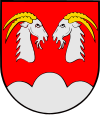Kozy
|
Kozy Seiffersdorf, Zajwyśdiüf |
||
|---|---|---|
| Village | ||

Kozy village
|
||
|
||
| Coordinates: 49°50′42″N 19°08′30″E / 49.84500°N 19.14167°ECoordinates: 49°50′42″N 19°08′30″E / 49.84500°N 19.14167°E | ||
| Country | Poland | |
| Voivodeship | Silesian | |
| County | Bielsko County | |
| Gmina | Kozy | |
| First mentioned | 1326 | |
| Area | 26.9 km2 (10.4 sq mi) | |
| Elevation | 375 m (1,230 ft) | |
| Population | 12,747 | |
| • Density | 476/km2 (1,230/sq mi) | |
| 2015 | ||
| Website | http://kozy.vot.pl/ | |
Kozy [ˈkɔzɨ] (German: Seiffersdorf, Seibersdorf, Kosy (1941–45); Wymysorys: Zajwyśdiüf) is a large village with a population of 12,457 (2013) within Bielsko County, located in the historical and geographical south-west region of Lesser Poland, between Kęty and Bielsko-Biała, and about 65 kilometres south-west of Kraków and south of Katowice. It is the largest village in Poland (by comparison - the population of Wyśmierzyce, the smallest town in Poland, is only 858). The village name translates to 'Goats' in English, and has an area of 26,9 km2.
Since 1 January 1999, following Polish local government reforms adopted in 1998, Kozy has been part of the newly established Silesian Voivodeship (province); between 1975-1998 it was formerly part of the Bielsko-Biała Voivodeship. The village is well connected with the nearby city of Bielsko-Biała. It has a railway transport station, and lies on National Road No. 52. Kozy is the centre of the administrative district of Gmina Kozy.
The village settlement was first mentioned in 1326 under two names "Duabuscapris seu Siffridivilla" in Latin, translated as "two goats or goats village", recorded in the parish Peter's Pence list, deanery of Oświęcim, Roman Catholic Archdiocese of Kraków. In old Polish the village was known as Dwyekozy (Dwiekozie);two goats, and consisted of two settlements - Upper Kozy (Kozy Górne), and Lower Kozy (Kozy Dolne).
...
Wikipedia


